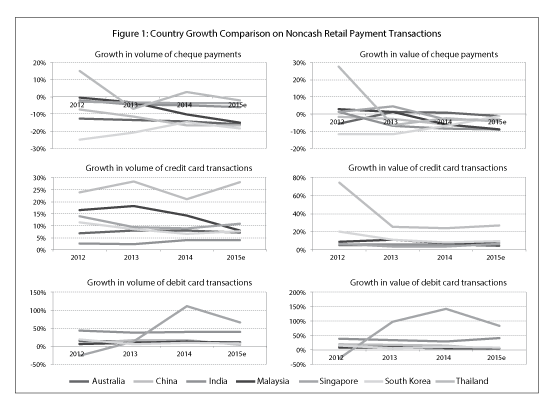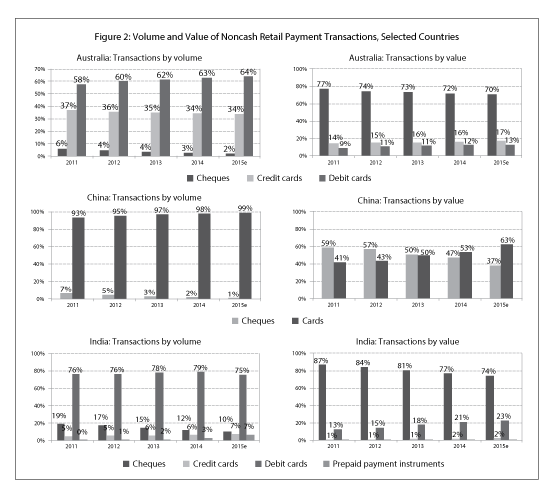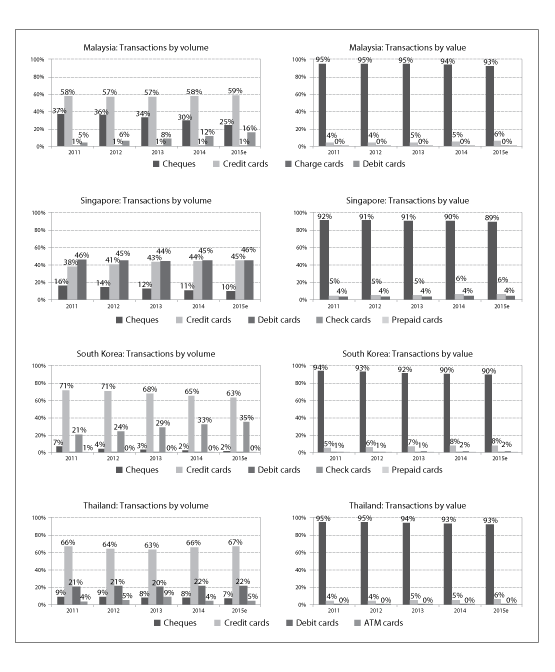Technological advances are changing the retail payment landscape significantly. Continuous retail payment innovations enable customers to make payments in more diverse ways and are also altering consumer payment behavior. Cash remains to be the most frequently used retail payment instrument, especially for small-value payments, but the use of noncash retail payment instruments is increasing. Transaction cost, transaction speed, convenience, and security are the primary factors affecting decisions of customers and businesses in the selection of payment instruments. The arrival of new payment instruments and nonbanking payment service providers has intensified the competition, which helps to lower transaction cost, enhance efficiency, and reduce risk.
A trend observed in all the seven countries covered in this report was that cheque payments, while remaining an important payment instrument in the near future, have shown a significant downward trend in recent years (Figure 1). Cheques are being used less compared to card payments and other electronic payment methods, which provide convenience as they require no clearing time. On average, the volume of cheques in these seven countries dropped by 9% and the value declined by 5% in 2014, and is expected to decrease further. China, India, and Thailand have seen the largest decline in the share of cheques by value in the past few years. In China, the volume and value of cheque payments went down by 17% and 6%, respectively, in 2014. However, cheques still account for a considerable portion of the value of noncash retail payment transactions, as some customers prefer to use cheques for large-value transactions.

Figure 2 shows that in Australia, Singapore, and Thailand, both credit cards and debit cards are experiencing flat growth in terms of value. In Australia, where almost 70% of credit card transactions are now tap and go, there is notable growth in volume for credit card but also debit card transactions. In China, card usage is very high and steeply rising, mirroring possibly the increasing household debt in the country. In India, the majority of payments are made using debit cards, as credit cards have exhibited slow adoption or low usage compared even to cheque payments. In Singapore, the volume of both credit card and debit card transactions is growing at an almost identical rate of 50%, while cheques still experience the highest growth in terms of value (90% on average). In South Korea, credit card usage has declined since 2012 but debit card usage is climbing. In Malaysia and Thailand, consumers use credit cards more than debit cards.
With continued growth in the availability of card terminals and rising card penetration rates, the card payment method is becoming more widely accepted. Card usage continues to increase as more and more customers use cards as a preferred payment instrument . The adoption of new technologies, such as PIN authentication and contactless card payment, is also one contributor to the observed change in the use of cards, as they make the transactions more efficient. Currently, contactless card payments only represent a small share of total card payments. However, this is expected to improve over time as more contactless terminals become available.

Figure 2. Continued.

The rise of new payment options has been tremendously changing the world of retail payments. New payment service providers have joined the competition, and are expected to play an increasingly important role in the payment market. Banks’ new competitors, such as telecommunications operators, technology providers, credit card companies, and online retailers are developing mobile digital wallet services to seize market share in mobile payments. Recently, immediate payments are gaining more attention, which will enable customers to receive better services and may help banks to become more competitive in payments.
With the advancement of technology, digital payment has been developed and more new payment products and services will be created. Although there is still a long way to go, increasing numbers of customers have moved to embrace these new electronic payments. Mobile payments, which are largely based on near-field communications technology, are still at a relatively early stage. With increasing internet and mobile penetration, internet payments and mobile payments will become attractive and widely used payment instruments among customers in the near future.

































